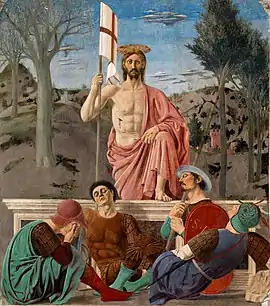| Arnold Comes of Age | |
|---|---|
 | |
| Artist | Grant Wood |
| Year | 1930 |
| Medium | Oil on pressed board |
| Dimensions | 26.75 in × 23 in (679 mm × 580 mm) |
| Location | Sheldon Museum of Art, Lincoln, Nebraska |
Arnold Comes of Age (originally Portrait of Arnold Pyle) is a 1930 oil painting by the American regionalist painter Grant Wood, created as a birthday gift for his studio assistant, Arnold Pyle. Wood took Pyle on as his protégé and was deeply affectionate towards him. The painting depicts a figure looking ahead in a rural landscape, as two nude men bathe in a river. It is reminiscent of Italian Renaissance artist Piero della Francesca's work, in particular The Resurrection, and it is interpreted, as homoerotic from its detailing.
Background and painting
Grant Wood was a regionalist painter from Iowa. During the Great Depression, he became one of the more prominent regionalists of the country.[1] Arnold Comes of Age was completed in 1930 in celebration of the twenty-first birthday of his studio assistant, Arnold Pyle.[2] Pyle, a painter himself and protégé of Wood, won blue ribbons at the Iowa State Fair for his art depicting the Midwest in 1933, and the grand prize in 1936.[3] He was heterosexual, and despite the affection that Wood showed him, did not romantically reciprocate—as Wood had done with many of his assistants, he disguised his outward affection as paternal love.[4]
The painting was originally entitled Portrait of Arnold Pyle.[5] It depicts an awkward young man looking at the viewer as a butterfly lands on his shirt, set in a countryside while two men bathe in a nearby river.[6] It is made of oil and is displayed on pressed board.[2] Its dimensions are 26.75 inches (67.9 cm) tall by 23 inches (58 cm) across.[2]
Interpretation

The art critic Luciano Cheles says that many of Wood's paintings—including his famous American Gothic—were inspired by works produced during the Italian Renaissance, especially those of the fifteenth-century artist Piero della Francesca.[1] Arnold Comes of Age may have been inspired by his painting The Resurrection, as the paintings share several similarities.[7] In both paintings, the central profile is "neatly" set apart from the background, looking at the viewer with a serious gaze; a figure with a distant look was a typical element of della Francesca's art.[7] The paintings also have two trees framing them: in Wood, one young and one mature, and in della Francesca, one bare and one full of leaves.[8] For Cheles, these contrasting trees represent life and death, as well as a general transition between two states.[9] Della Francesca also painted The Baptism of Christ, and Cheles argues that the nude bathers in Wood's painting are similar to that work.[9] These bathers may symbolize baptism, and consequently, one coming of age.[9]
Ulysses Grant Dietz, a former curator of The Newark Museum of Art, said that the painting indicates an "obvious love" for Arnold.[10] Details such as recurrent couplings (of trees, bushes, and stacks of hay) may demonstrate a love for Pyle, and the two nude swimmers in the back could represent the Christian figures Adam and Eve in the Garden of Eden.[4] Wood chose to sign his name beside Pyle's beltbuckle—adorned with AP, for Arnold Pyle—perhaps so the two men could have their names forever linked.[4] Arnold Comes of Age also depicts a butterfly—which was understood at the time as a gay symbol—landing on Arnold's shirt.[11] The painting is thought to be homoerotic,[12] although critic Faye Hirsch says this interpretation allows researchers to make claims about Wood's life with only minimal evidence.[13]
History
After Arnold Comes of Age was completed, Wood entered it into the 1930, Iowa State Fair Art Salon.[5] Wood was well-established at the time and had earlier exhibited at galleries in Paris.[5] However, as a regionalist committed to promoting the artistic movement, he decided to show Arnold Comes of Age and other paintings in Iowa instead.[5] Arnold Comes of Age won the grand prize, and his painting Stone City, Iowa won the landscape category.[5]
Arnold Comes of Age was displayed in a 1940 Nebraskan show alongside Stone City, Iowa and John B. Turner, Pioneer,[14] a portrait of the father of his patron David Turner that Wood completed in 1929–30.[15] These were all offered for sale, each at a price of between $300 and $400.[14] The board of trustees for the Nebraska Art Association paid $300 for Arnold Comes of Age, while the Joslyn Art Museum of Omaha acquired Stone City, Iowa.[14] It has since become one of the most valuable pieces within the Association's permanent collection,[14] and resides at the Sheldon Museum of Art in Lincoln, Nebraska.[16] The Sheldon Museum of Art holds the artwork of the association, the University of Nebraska–Lincoln, and other collections.[17]
For years, it was not shown publicly due to its significant deterioration: discoloration, extensive craquelure, and varnish disappearance plagued the painting.[18] The bathing figures were, according to Donald Bartlett Doe of the Sheldon, "nearly obliterated".[18] These problems began some ten years after its completion, but by 1985, they were addressed through restoration.[18]
References
Citations
- 1 2 Cheles 2016, p. 106.
- 1 2 3 Cheles 2016, p. 112.
- ↑ Rasmussen 1995, pp. 18, 20, 28.
- 1 2 3 Darnaude 2021, p. 20.
- 1 2 3 4 5 Rasmussen 1995, p. 17.
- ↑ Kinloch 2014, pp. 162–163.
- 1 2 Cheles 2016, pp. 112–114.
- ↑ Cheles 2016, pp. 112–113.
- 1 2 3 Cheles 2016, p. 113.
- ↑ Dietz 2018, pp. 165, 167.
- ↑ Ventura 2018.
- ↑ Doss 2018, p. 40.
- ↑ Hirsch 2011, p. 79.
- 1 2 3 4 Wells 1972, p. 21.
- ↑ Corn 1983, p. 68.
- ↑ Sheldon.
- ↑ Wells 1972, p. 39.
- 1 2 3 Doe 1985.
Bibliography
- Cheles, Luciano (Spring 2016). "The Italian Renaissance in American Gothic: Grant Wood and Piero della Francesca". American Art. 30 (1): 106–124. doi:10.1086/686551. S2CID 190856739.
- Corn, Wanda M. (1983). Grant Wood: The Regionalist Vision. Minneapolis Institute of Art; Yale University Press. ISBN 0-300-03103-3. OCLC 9324205.
- Darnaude, Ignacio (1 November 2021). "Grant Wood left tipoffs all over". The Gay & Lesbian Review Worldwide (November–December 2021). Gale A680295004.
- Dietz, Ulysses Grant (4 May 2018). "Grant Wood: American Gothic and Other Fables". The Journal of Modern Craft. 11 (2): 165–167. doi:10.1080/17496772.2018.1493789. S2CID 218838538.
- Doe, Donald Bartlett (1985). "Before and after". Resource/Reservoir. Sheldon Memorial Art Gallery. 1 (3). Retrieved 16 November 2021.
- Doss, Erika (March 2018). "Grant Wood's queer parody: American humor during the Great Depression". Winterthur Portfolio. 52 (1): 3–45. doi:10.1086/697497. S2CID 166213182.
- Hirsch, Faye (1 February 2011). "Seeing queerly". Art in America. 99 (2).
- Kinloch, David (4 May 2014). "Hide and seek: Mimesis and narrative in ekphrasis as translation". New Writing. 11 (2): 155–166. doi:10.1080/14790726.2014.882959. S2CID 143847309.
- Rasmussen, Chris (1995). "Agricultural lag: The Iowa State Fair Art Salon, 1854-1941". American Studies. 36 (1): 5–29. ISSN 0026-3079. JSTOR 40643728.
- Ventura, Anya (10 June 2018). "Sultry night: Grand Wood's queer Midwest". Grant Wood Art Colony. Retrieved 15 November 2021.
- Wells, Fred N. (1972). The Nebraska Art Association: A history 1888–1971. OCLC 10328820. Retrieved 15 November 2021.
- "Wood, Arnold". Sheldon Museum of Art. Retrieved 15 November 2021.